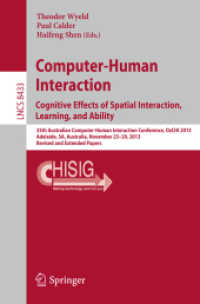- ホーム
- > 洋書
- > 英文書
- > Religion / Ethics
基本説明
Provides a scholarly investigation of a movement that changed the history of Protestantism. The Pietists can be credited with inspiring both Evangelicalism and modern individualism.
Full Description
"An Introduction to German Pietism" provides a scholarly investigation of a movement that changed the history of Protestantism. The Pietists can be credited with inspiring both Evangelicalism and modern individualism. Taking into account new discoveries in the field, Douglas H. Shantz focuses on features of Pietism that made it religiously and culturally significant. He discusses the social and religious roots of Pietism in earlier German Radicalism and situates Pietist beginnings in three cities: Frankfurt, Leipzig, and Halle. Shantz also examines the cultural worlds of the Pietists, including Pietism and gender, Pietists as readers and translators of the Bible, and Pietists as missionaries to the far reaches of the world. He not only considers Pietism's role in shaping modern western religion and culture but also reflects on the relevance of the Pietist religious paradigm of today. The first survey of German Pietism in English in forty years, "An Introduction to German Pietism" provides a narrative interpretation of the movement as a whole.
The book's accessible tone and concise portrayal of an extensive and complex subject make it ideal for courses on early modern Christianity and German history. The book includes appendices with translations of German primary sources and discussion questions.
Contents
List of Figures, Maps, and Tables
Foreword, by Peter C. Erb
Acknowledgments
Introduction: Issues in Defining and Describing the Pietist Movement
Part I: The Setting and Inspiration for German Pietism
1. German Radicalism and Orthodox Lutheran Reform
2. The Thirty Years War, Seventeenth-Century Calvinism, and Reformed Pietism
Part II: A Tale of Three Cities
3. Beginnings of Lutheran Pietism in Frankfurt,1670 to 1684
4. Conventicles and Conflicts in Leipzig andthe Second Wave, 1684 to 1694
5. Halle Pietism and Universal Social Reform,1695 to 1727
Part III: The Social and Cultural Worlds of German Pietism
6. Radical German Pietism in Europe and North America
7. Pietism and Gender
8. Pietism and the Bible
9. Pietism, World Christianity, and Missions to South India and Labrador
Part IV: Pietism and Modernity
10. The Contribution of German Pietism to the Modern World
Conclusion: Reflecting on the Cultural and Religious Legacy of German Pietism
Appendixes
A. Sources in Translation
B. Translation of Georg Heinrich Neubauer's "183 Questions" (1697)
C. Discussion Questions
D. Student Members of the Leipzig Circle of Pietists in the Late 1680s
Notes
Bibliographies and Further Reading
Index of Persons and Places






